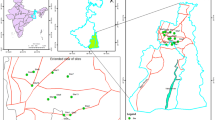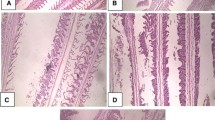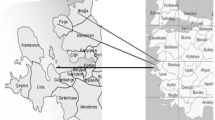Abstract
This study highlights the enzyme profile of Oreochromis mossambicus exposed to electroplating industry wastewater. The need for this task arises from the trend of releasing the untreated electroplating industrial wastewater into the environment, which may pose a problem to the aquatic organism and human. The bioassays conducted to test heavy metals chromium or nickel separately as well as their combination in the electroplating industrial wastewater against the fish, O. mossambicus. This study exposed the high enhancement of Lactate dehydrogenase and severe declining of succinate dehydrogenase in liver, gill and muscle tissue of fish treated in the highest concentration of electroplating industrial wastewater compared to that of chromium or nickel. Thus this study projects the synergistic effect of heavy metals present in the electroplating industry wastewater on the enzymatic activity in the vital organs of fish, Oreochromis mossambicus.






Similar content being viewed by others
References
AntonyRaj SM, Murugesan AG, Haniffa MA (1987) Toxicity of industrial effluents to the freshwater catfish, Mystus keletius. Curr Sci 56:732–734
APHA (1975) Standard methods for the examination of water and wastewater, 14th edn. American Public Health Association, American Water Works Association and Water Pollution Control Federation, Washington
APHA-AWWA-WPCF (1992) Standard methods for the examination of water and wastewater. Clesterel LS, Greenberg AE, Eaton AD (eds), 18th edn. American Public Health Association, American Water Works Association and Water Pollution Control Federation, Washington
Broderius GR, Smith LL (1979) Lethal and sublethal effects of binary mixtures of cyanides and hexavalent chromium, zinc or ammonia to the fathead minnow (Pimephales promelas) and rainbow trout (Salmo gairdneri). J Fish Res Board Can 36:164–172
Buhler DR, Stokes RM, Coldwell RS (1976) Tissue accumulation and enzymatic effects of hexavalent chromium in rainbow trout (Salmo gairdneri). J Fish Res Board Can 34:9–16
Cabaud L, Wrobelewski S, Ruggier T (1958) Estimation of LDH activity. Am J Clin Pathol 30:234–239
DelRamo J, Diaz Mayans J, Torryblanca A, Nunez A (1987) Effects of temperature on the acute toxicity of heavy metals (Cr, Cd and Hg) to the freshwater cray fish Procambarus clarkii (Girard). Bull Environ Contam Toxicol 38:736–741
Doudoroff P, Katz M (1950) Critical review of literature on the toxicity of industrial wastes and toxic components to fish. In: Sew ind wastes, vol 22, pp 1432–1458
Finney DJ (1978) Statistical methods in biological assay, 3rd edn. Ovilfin Press, London, p 508
Forstner U, Wittmann GTW (1983) Metal pollution in the aquatic environment. Springer, New York, p 485
Haniffa MA, Porchelvi M (1985) Effect of distillery effluent on oxygen consumption of freshwater fish, Sarotherodon mossambicus. J Environ Biol 19(1):67–71
Hardy R (1980) Fish feed formulation. In: Fish feed technology, agriculture development and coordination programme, FAO/ADCP/Rep/80/11, pp 233–239
Heath AG (1987) Water pollution and fish physiology. In: Chap 8. Physiological energetics. CRC Press, Boca Raton, p 235
Jana S, Sahana SM (1988) Effect of copper, cadmium, chromium cations on the freshwater fish, Clarias batrachus L. Physiol Bohemoslov 37(1):79–82
Larsson A, Bengtsson BE, Svanberg O (1976) Some hematological and biochemical effects of cadmium on fish. In: Lockwood APM (ed) Effects of pollutants on aquatic organisms, vol 2. Cambridge University Press, London, pp 35–45
Lehninger AL (1982) In: Principles of biochemistry. Worth Publishers Incorporations, New York, p 330
Michalak A, Bulinski R (1995) Studies on some trace element content in home food products. Part XVIII: Lead, cadmium, nickel, zinc, copper and chromium content in some chilled freshwater and seafish. Bromatol Chem Toksykol 28(1):33–38
Natchlos MM, Morghils SP, Serigman AM (1960) A calorimetric method by the determination of succinate dehydrogenase activity. J Biol Chem 235:490–510
Navaraj PS (2003) Synergetic effect of metals of electroplating industry effluent on physiology of the fish, Oreochromis mossambicus. J Phys IV 107:925–928. doi:10.1051/jp4:20030450
Navaraj PS, Kumaraguru AK (2003a) Effects of electroplating effluent on haematological parameters of Oreochromis mossambicus. J Phys IV 107:935. doi:10.1051/jp4:20030452
Navaraj PS, Kumaraguru AK (2003b) Effects of electroplating effluent on histopathological study of Oreochromis mossambicus. J Phys IV 107:929–934. doi:10.1051/jp4:20030451
O’Brien RD (1967) Insecticides action and metabolism Academic Press, New York, pp 45–49
Rady AA, Saber N, Kotkat HM, Matkovics B, Nour AM (1992) Metals effect on fish tissues: I. Effects of chronic mercury and selenium treatment on young tilapia tissue enzymes and lipid peroxidation. Acta Univ Szeged Biol 38(1–4):3–9
Reddy MM, AnandaKumar V, Reddy PS, Reddy SLN (1993) Phenol induced in the brain and muscle of freshwater fish, Channa punctatus during sublethal toxicosis. J Ecotoxicol Environ Monit 3(1):13–17
Robinson J, Oldewage AA (1997) Chromium, copper, iron and manganese bioaccumulation in some organs and tissues of Oreochromis mossambicus from the lower Olifants River, inside the Kruger National Park. Water SA 23(4):387–403. Pretoria
Saber N, Rady AA, Matkovics B, Nour AM (1992) Metals effect on fish tissues: II. The effect of chronic zinc and cadmium treatment on young tilapia tissue enzymes and lipid peroxidation. Acta Univ Szeged Biol 38(1–4):11–18
Sastry KV, Sachdeva S, Rathee P (1997) Chronic toxic effects of cadmium and copper, and their combination on some enzymological and biochemical parameters in Channa punctatus. J Environ Biol 18(3):291–303
Shaffi SA (1980) The acute industrial effluent toxicity to freshwater fish. Toxicol Lett 5(3–4):183–190
Shaffi SA (1993) Comparison of the sublethal effect of mercury and lead on visceral dehydrogenase system in three inland teleosts. Respir Physiol 42(1):7–15
Sharma G, Singhal KC (1993) The effect of cadmium on the digestive system of the teleost fish, Heteropneustes fossilis. Bull Pure Appl Sci 12A(1&2):31–36
Sprague JB (1971) Measurement of pollutant toxicity to fish. III. Sublethal effects and safe concentrations. Water Res 5:245–266
Tokarski E, Lembity R (1978) Effect of lead on thiamine status and function in liver and blood of rats. Acta Chem Scand, Ser B, Org Chem Biochem 32:375–379
Warner RE (1967) Bioassays for microchemical environmental contaminants. Bull World Health Organ 36:181–207
Webb PW, Brett JR (1972) The effects of sublethal concentration of whole bleached kraft mill effluent on the growth and food conversion efficiency of under-yearling sockeye salmon (Oncorhyncus nerks). J Fish Res Board Can 29:1555–1563
Acknowledgements
The authors thank the Management of Madurai Kamaraj University and Yadava College, Madurai, for permitting to carry out this experiment. The University Grants Commission, New Delhi, deserves our appreciation for their fellowship award to carry out this work.
Author information
Authors and Affiliations
Corresponding author
Rights and permissions
About this article
Cite this article
Perumalsamy, N., Arumugam, K. Enzymes Activity in Fish Exposed to Heavy Metals and the Electro-Plating Effluent at Sub-Lethal Concentrations. Water Qual Expo Health 5, 93–101 (2013). https://doi.org/10.1007/s12403-013-0092-4
Received:
Revised:
Accepted:
Published:
Issue Date:
DOI: https://doi.org/10.1007/s12403-013-0092-4




